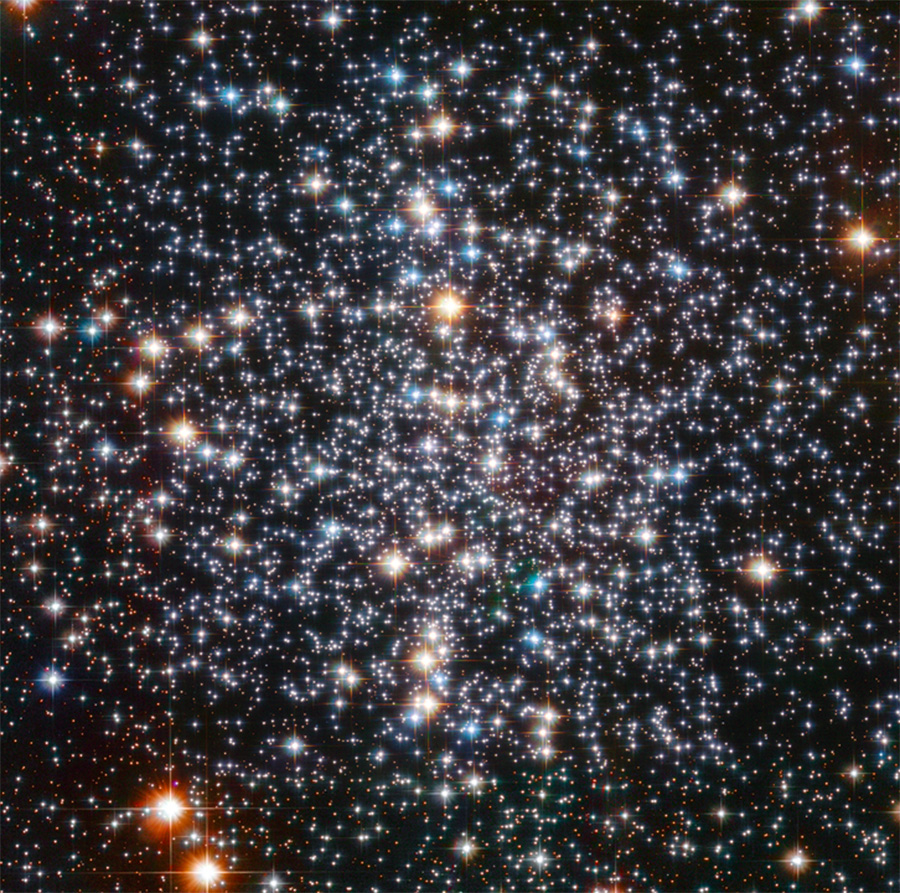The well-known star cluster Messier 4 might have an elusive, midsize black hole hidden at its center, but the evidence isn’t conclusive yet.

NASA / ESA / Eduardo Vitral (STScI)
In a recent study using data from the Hubble Space Telescope and the Gaia spacecraft, astronomers report evidence that Messier 4, a globular cluster in the constellation Scorpius, could have a mid-size black hole lurking in its core. If the claim pans out — and that’s still up in the air — it would lend credence to the idea that at least some of these “missing links” are hiding inside dense star clusters.
We’ve seen evidence for stellar-mass black holes, the result of collapsing stars, and we’ve observed supermassive black holes in the centers of galaxies. But there is a mysterious gap in between the two: We’ve never seen hard evidence for intermediate-mass black holes (IMBH).
Previously, observations have turned up hints of these objects. The LIGO and Virgo gravitational-wave instruments detected a black hole-binary collision of about 150 solar masses in 2020. X-ray observations have turned up a number of IMBH at the centers of dwarf galaxies. And there are a few tentative detections in star clusters.
Globular clusters in particular are of interest for IMBH searches. These spherical formations contain anywhere from thousands to millions of stars, packed so densely that we don’t really know what is at their centers.
See Sky & Telescope’s November 2022 issue for a survey of recent searches for intermediate-mass black holes. (Non-subscribers may preview the issue at the link.)
Eduardo Vitral (Space Telescope Science Institute) led a team that analyzed the proper motions of stars as they whizzed around the core of the globular cluster Messier 4 (M4). Hubble measured the motions of central stars, while Gaia provided the shape and mass of the cluster itself based on observations of 6,000 individual stars.
“We modeled a few different scenarios,” Vitral says. “Firstly, how an IMBH would affect the motions of the stars in the cluster, compared to a few stellar black holes, and also if there was no dark component present.” He and his team concluded that those motions might indicate the presence of a single IMBH of roughly 800 times the Sun’s mass. Alternatively, there could be a central swarm of stellar remnants, such as black holes, neutron stars, or white dwarfs.
But not everyone thinks globular clusters like M4 are the best place to look for IMBHs. “There really might be globular clusters that could have IMBHs, like Omega Centauri or NGC 6388, but M4 looks pretty normal to me,” cautions Holger Baumgardt (University of Queensland, Australia), who was not involved in the study. “Their results are down to their model. I have modeled M4 and don’t think an IMBH is needed. It’s certainly not definitive.” (Baumgardt has posted his analyses online.)
Baumgardt says that Vitral’s model does not account for mass segregation, in which heavier stars will gradually “sink” toward a cluster’s center, while lighter members move toward the edges. If this effect is included, it’s possible that the stellar proper motions that Hubble and Gaia detected in the core could be explained by a central concentration of stellar remnants such as neutron stars and white dwarfs.
Vitral argues that the effects of mass segregation would be smaller than the uncertainties in their dataset. But he agrees that the results are inconclusive, adding that this study primarily sets the scene for future studies.
Ideally, more observations of the cluster from Hubble as well as the James Webb Space Telescope would lengthen the time over which proper motions are measured as well as more accurately measure the stars’ brightness. The increase in quality of the measurements will help give a more definitive answer about what’s really hiding in the core of M4.
 3
3









Comments
Martian-Bachelor
June 2, 2023 at 11:10 pm
Baumgardt's site shows a central velocity dispersion for the stars in M4 of about 5 km/sec. This is right about an AU per year.
But at M4's distance (1,850 pc), HST's resolution of 0.1 arc-second is 185 AU's. Maybe I'm missing something, but it would seem you'd need many years or decades to measure proper motions for stars moving across the line of sight at that velocity at that distance.
You must be logged in to post a comment.
Mountainfisher
June 3, 2023 at 1:33 am
They've measured the movement of Caldwell 80 (Omega Centauri) as well using more than just Hubble, but Gaia, Spitzer and Chandra space telescopes. As it is suspected from its different Metallicity that it may be a dwarf elliptical galaxy with indications of C-80 having a black hole, but it is also not a certainty. How they measured its stars isn't something I'd know about, but they say they've measured it and other astronomers concur. Perhaps an article of the process they go through to do such measurements would make for interesting reading.
You must be logged in to post a comment.
Lou
July 13, 2023 at 5:18 am
Hubble uses its fine-guidance sensors for astrometry, which have an interferometric mode capable of 1 milliarcsecond resolution. 🙂
You must be logged in to post a comment.
You must be logged in to post a comment.